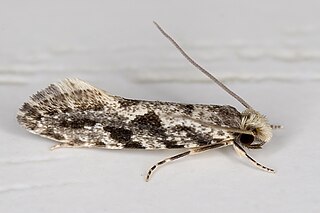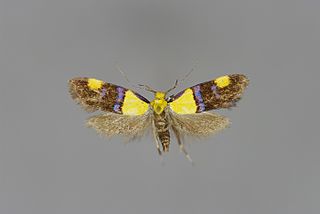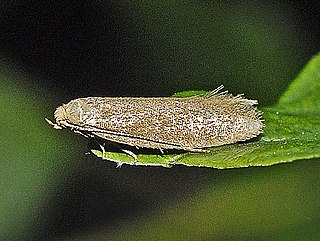
Argyresthia curvella is a species of ermine moth. It belongs to subfamily Argyresthiinae, which is sometimes elevated to full family rank in the superfamily Yponomeutoidea. It is commonly called apple blossom tineid, reflecting the fact that it was originally believed to be a tineid moth.

Olethreutes arcuella, the arched marble, is a colorful small moth species of the family Tortricidae.

Euplocamus anthracinalis is a species of tineoid moth. It belongs to the fungus moth family (Tineidae), and among these to the subfamily Euplocaminae.

Monopis obviella is a species of tineoid moth. It belongs to the fungus moth family (Tineidae), and therein to the nominate subfamily Tineinae. It is the type species of Blabophanes, today treated as a junior synonym of the genus Monopis. M. crocicapitella was only separated from the present species in 1859, and is still frequently confused with it even by rather recent sources.

Nemapogon granella is a species of tineoid moth. It belongs to the fungus moth family (Tineidae), and therein to the subfamily Nemapogoninae. It is the type species of its genus Nemapogon, and via that also of the subfamily Nemapogoninae. It is also the type species of the proposed genera Brosis and Diaphthirusa, which are consequently junior objective synonyms of Nemapogon.

Tinea semifulvella is a species of tineoid moth. It belongs to the fungus moth family (Tineidae), and therein to the nominate subfamily Tineinae. It is widespread and common in much of the western Palearctic, but seems to be absent from Portugal and the Balkans as well as the outlying islands. The nocturnal adults are on the wing around May to September, depending on the location, and are easily attracted to light sources.

The brown-dotted clothes moth is a species of tineoid moth. It belongs to the fungus moth family (Tineidae), and therein to the nominate subfamily Tineinae. It is the type species of its genus Niditinea.

Batia lunaris, the lesser tawny crescent, is a species of gelechioid moth. It belongs to the subfamily Oecophorinae of the concealer moth family (Oecophoridae). It is the type species of the genus Batia, which is sometimes treated as monotypic. But this is not well warranted, as some other species usually placed there differ little from the Lesser Tawny Crescent.

Nemapogon cloacella, the cork moth, is a species of tineoid moth. It belongs to the fungus moth family (Tineidae), and therein to the subfamily Nemapogoninae. Its junior synonym N. infimella was established by G.H. Heydenreich in the 1851 volume of his Lepidopterorum Europaeorum Catalogus Methodicus, but many sources still attribute it to G.A.W. Herrich-Schäffer, who supposedly narrowly beat Heidenreich in (re)describing the species. But as it seems, Herrich-Schäffer was merely one of the first to use the name proposed by Heydenreich, as the volume of his Systematische Bearbeitung der Schmetterlinge von Europa where he discussed the cork moth was not published until 1853 or 1854. That all nonwithstanding, the species had been already validly described by A.H. Haworth in the 1828 volume of Lepidoptera Britannica.

Oecophora bractella is a species of gelechioid moth. It belongs to the subfamily Oecophorinae of the concealer moth family (Oecophoridae). As the type species of its genus Oecophora, its affiliations and phylogeny determine the delimitation of that family and subfamily.

Esperia oliviella is a species of gelechioid moth.

Borkhausenia minutella is a species of moth. Within its superfamily, it is placed within the subfamily Oecophorinae of the "concealer moth" family, Oecophoridae.

Alabonia geoffrella is a species of gelechioid moth. Here, it is placed within the subfamily Oecophorinae of the concealer moth family (Oecophoridae). Alternatively it has been placed in the Elachistidae or Depressariinae together with its presumed closest relatives.

Agnoea josephinae, the orange-headed tubic, is a species of moth in the family Lypusidae. It is found in Europe.

Agnoea subochreella, the Straw-coloured Tubic, is a species of gelechioid moth in the family Lypusidae.

Tinea trinotella is a species of tineoid moth. It belongs to the fungus moth family (Tineidae), and therein to the nominate subfamily Tineinae. It was once used as type species of a distinct genus Acedes, but this is synonymized today with Tinea, the type genus of Tineinae, Tineidae and the superfamily Tineoidea.

Agnoea is a genus of butterflies in the moth family Lypusidae. There are more than 20 described species in Agnoea.
Agnoea detrimentella is a species of moth in the family Lypusidae. It is found in Spain and Portugal.
Agnoea subgilvida is a species of moth in the family Lypusidae, found on Corsica.

Hypsopygia glaucinalis is a moth of the family Pyralidae. It is sometimes placed in the genus Orthopygia either alone or with a few other species. Being the type species of Orthopygia, as soon as O. glaucinalis is placed in Ocrasa"Orthopygia" is abolished. To further complicate matters, Ocrasa is now mostly treated as a synonym or subgenus of Hypsopygia.



















